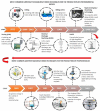Analysis and Advances in Additive Manufacturing as a New Technology to Make Polymer Injection Molds for World-Class Production Systems
- PMID: 35566816
- PMCID: PMC9105666
- DOI: 10.3390/polym14091646
Analysis and Advances in Additive Manufacturing as a New Technology to Make Polymer Injection Molds for World-Class Production Systems
Abstract
The currently growing demand for metallic and polymeric products has undoubtedly changed the rules of manufacturing, enabling customers to more functionally define their products based on their needs. Nowadays, a new technique for rapid tooling, Additive Manufacturing (AM), can create customized products with more complex geometries and short life cycles (flexibility) in order to keep up with the new variables imposed by the manufacturing environment. In the last two decades, the migration from subtractive manufacturing to AM has materialized such products with reduced costs and cycle times. AM has been recently promoted to develop polymer molds for product manufacturing. This paper reviews the main findings in the literature concerning polymer molds created by AM compared to conventional (metal) molds obtained by subtractive manufacturing. Information about specific topics is scarce or nonexistent, for example, about the characterization of the most commonly injected materials and molds used in this type of technology, their mechanical properties (part and mold), designs for all types of geometries, and costs. These aspects are addressed in this literature review, highlighting the advantages of this alternative manufacturing process, which is considered a desirable technology worldwide.
Keywords: injection molding; mold additive manufacturing; mold characterization; polymer molds; rapid tooling; subtractive manufacturing.
Conflict of interest statement
The authors declare no conflict of interest.
Figures







References
-
- Kampker A., Triebs J., Alves B., Kawollek S., Ayvaz P. Potential analysis of additive manufacturing technologies for fabrication of polymer tools for injection moulding—A comparative study; Proceedings of the 2018 IEEE International Conference on Advanced Manufacturing (ICAM); Yunlin, Taiwan. 16–18 November 2018; pp. 49–52. - DOI
-
- Wu T., Jahan S.A., Zhang Y., Zhang J., Elmounayri H., Tovar A. Design Optimization of Plastic Injection Tooling for Additive Manufacturing. Procedia Manuf. 2017;10:923–934. doi: 10.1016/j.promfg.2017.07.082. - DOI
-
- Bogaerts L., Faes M., Bergen J., Cloots J., Vasiliauskaite E., Vogeler F., Moens D. Influence of thermo-mechanical loads on the lifetime of plastic inserts for injection moulds produced via additive manufacturing. Procedia CIRP. 2021;96:109–114. doi: 10.1016/j.procir.2021.01.061. - DOI
-
- Walsh E., ter Horst J.H., Markl D. Development of 3D printed rapid tooling for micro-injection moulding. Chem. Eng. Sci. 2021;235:116498. doi: 10.1016/j.ces.2021.116498. - DOI
-
- Zink B., Kovács N.K., Kovács J.G. Thermal analysis based method development for novel rapid tooling applications. Int. Commun. Heat Mass Transf. 2019;108:104297. doi: 10.1016/j.icheatmasstransfer.2019.104297. - DOI
Publication types
LinkOut - more resources
Full Text Sources

